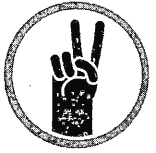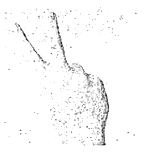-
People use the V-sign, standing for “victory” around the world. Where did the i_______ come from? Well, it started during World WarⅡ.
On January 4, 1941, a Belgian whose first name was Victor made a radio broadcast to his countrymen. He found a new way of striking at the Nazi occupiers(占领). That was the V-sign. The letter “V” stood not only for his first name, but also for w_______ “victory.” Certainly, the sign became p_______ quickly and was accepted by British Prime Minster, Winston Churchill. Every time he posed(摆姿势)for a c_______, he gave his famous “V” for “Victory.”
The V-sign can be made with the palm(手掌)of the hand facing in, or facing out. H_______, there is a great difference between the two gestures in the UK. With the palm facing out, the gesture means “victory,” with the palm facing in, the gesture is an insult(侮辱). Sometimes this will c_______ some misunderstanding for a visitor to Britain. For example, in a pub, a Canadian has ordered two beers with his palm facing in, but half an hour later, the waiter still doesn’t come to serve him.


1.i________
2.w______
3.p_________
4.c___________
5.H_________
6.с_________
-
Nowadays, bicycles are very popular around the world. In some places, people use a bicycle___ to work. Some people even ride their bicycles ____ exercise. But Do you know who____ the first bicycle?
In 1771, a Frenchman named Sivrac invented the first bicycle. The handles(柄,把手)and the seat looked ______ a horse and were made of wood. This bicycle was very difficult _____.
In 1817, a German named Sauerbrun made the first bicycle _____. The seat was more comfortable. The wheels(轮子) could change direction.____ in the forest took only one hour instead of three hours on foot. But these bicycles still had no brakes(刹车), and people often ____.
It took another 45 years for the bicycle ____ popular again. Over 100 years later, bicycle riding is ____ popular than before. In fact, there are more bicycles than cars in the world today.
1.A. go B. to go C. goes D. going
2.A. for B. at C. on D. in
3.A. invent B. invention C. invented D. inventing
4.A. at B. for C. after D. like
5.A. move B. to move C. moving D. moved
6.A. good B. well C. better D. best
7.A. Ride B. Riding C. Rode D. Ridden
8.A. fell down B. fell behind C. fell out D. fell away
9.A. become B. becoming C. to become D. became
10.A. a little B. even more C. the most D. much
-
We use emojis (表情) a lot, but most people don’t know what feelings they stand for __________.
A.exactly B.mostly C.mainly D.finally
-
After wandering around in the city for a long time, Tom finally found himself standing in front of the royal palace. He looked _______ its golden gate, hoping to catch a glimpse of a real prince.
There were several guards standing at both sides of the gate. Tom, dressed in rags, was moving slowly past them when he _______ caught sight of a well-dressed boy who was followed by several servants. He was no doubt the prince!
Tom was _______. He wanted to get close to the prince and have a good look at him. However, a guard saw him and stopped him rudely.
The young prince, called Edward, was angry with the guard for his rudeness. He asked the guard to _______ the gate and took Tom to his room in the palace.
The two boys became good friends. They even exchanged their clothes after Tom told Edward that he had dreamt about dressing like a prince. As they stood side by side in front of a great mirror, they were surprised to find that they looked almost like twins! The two boys were in each other’s clothes when Edward suddenly noticed a bruise(瘀伤)on Tom’s hand. He soon _______ that it was caused by the guard who had treated Tom rudely. In a moment, the young prince had run out of the room. He decided to punish the guard.
_______, the guard didn’t recognize the prince who was in Tom’s old torn clothes. He hit Edward heavily on the ear and threw him out of the palace.
1.A.at B.through C.for D.after
2.A.suddenly B.gently C.fiercely D.heavily
3.A.frightened B.upset C.worried D.excited
4.A.repair B.paint C.open D.close
5.A.decided B.realized C.discussed D.dreamed
6.A.Besides B.So C.However D.Therefore
-

After wandering around in the city for a long time, Tom finally found himself standing in front of the palace. He looked through its golden gate, hoping to take a look at a real prince. There were some guards standing at both sides of the gate. Tom, dressed badly, was moving nervously past them when he suddenly caught sight of a well-dressed boy who was followed by several servants. He was no doubt the prince!
Tom was excited. He wanted to get close to the prince and have a good look at him.
However, a guard saw him and stopped him rudely.
The young prince, whose name was Edward, was angry with the guard for his rudeness. He asked the guard to open the gate and took Tom to his room in the palace.
The two boys became good friends. They even exchanged their clothes after Tom told Edward that he had dreamt about dressing like a prince. As they stood side by side in front of a great mirror, they were surprised to find that they looked almost like twins!
The two boys were in each other's clothes when Edward suddenly noticed a bruise on Tom's hand. He soon realized that it was caused by the guard who had stopped Tom rudely. In a moment, the young prince ran out of the room. He decided to punish the guard.
However, the guard didn't realize that the prince was in Tom's old worn clothes. He hit Edward heavily on the ear and threw him out of the palace.
1.Why did Tom look through the gate of the palace?
A.To talk with the guard. B.To ask for a place to live in.
C.To have a look at a real prince. D.To live in the palace.
2.When Tom was stopped, Edward got mad because of .
A.the bad manners of Tom B.the strict rules of the palace
C.the uncomfortable words of the king D.the rude behavior of the guard
3.Which of the following is TRUE according to the passage?
A.Edward and Tom were twin brothers.
B.Edward was kind, caring and friendly.
C.Edward was tired of living in the palace.
D.Tom wanted to be a real prince.
-
I don't _______ the heat, for I'm used to hot weather.
A. like B. mind C. know D. stand
-
---The changes are good for people.
-- ________I like the present transport but I can’t stand(忍受)the pollution.
A. Yes, I agree with you B. No, I don’t agree with you
C. Yes, I’m afraid so D. In some ways, I agree with you
-
— The changes are good for people.
— ________. I like the transport but I can’t stand the pollution.
A.Yes, I agree with you. B.No, you are wrong.
C.In some ways, I agree with you. D.No, I agree with you.
-
People in different countries have different hobbies around the world.For example,in America people’s favorite hobby is watching TV in their spare time.It is the main entertainment for Americans to watch TV at least one hour in a day.96% of the Americans see watching TV as their first hobby.The second one is going to the cinema or doing some sports.Next is reading or gardening.Except these,fishing is also a very popular hobby.
In England,it’s quite different.People there like to go to the flea market(跳蚤市场).They like to go there to see if there is something new.In addition,Englishmen like drinking tea.
Russians like reading very much.Wherever you go,you will see the people who are reading carefully.Germans like reading as well.According to a survey,Germans read 15 books on average in 2012.
1.How many kinds of hobbies that Americans have are mentioned in this article?
A. Four. B. Five. C. Six. D. Seven.
2.What is the first hobby for Americans?
A. Watching TV.
B. Going to the cinema.
C. Doing some sports.
D. Reading.
3.Where do Englishmen like to go in their spare time?
A. Garden. B. Flea market.
C. Library. D. Cinema.
4.The people in like reading very much.
A. Russia and England
B. Russia and Germany
C. America and England
D. England and Germany
5.The people in like drinking tea.
A. America B. England
C. Russia D. Germany
-
The Spring Festival is the biggest festival for Chinese people all around the world. The celebration usually lasts for 15 days. There is a lot to do.
On the eve of the Spring Festival, family members get together and have big meals. Their favorite dish on this day is dumplings.
Days before the Spring Festival, families will clean their homes. People think cleaning sweeps away bad luck. It makes the house ready for good luck.
The color red is everywhere during the Spring Festival. People think red is a happy color and will bring them a bright future. People wear red, too. They decorate (装饰) their homes with pieces of red paper. Kids get a lot of “hong bao”. It is a red paper bag with money in it. Usually, older people give younger ones hong bao. They think it brings good luck.
The Spring Festival is the time to make everybody happy. So don’t say any bad words or do anything that will bring unhappiness to other people. For example, you’d better not say any bad words like “death”. Don’t break anything. People think that it means your luck is running out.
Also, don’t borrow or lend money on these days. If you have borrowed money, return it before the Spring Festival.
1.What do most people do on the eve of the Spring Festival?
A. Family members get together for a big meal.
B. Friends eat dumplings together.
C. They borrow money from friends.
D. They give each other hong bao.
2. Why do people clean their houses days before the Spring Festival?
A. Because they enjoy being clean.
B. Because it is believed that cleaning will sweep away bad luck.
C. Because they think it will bring happiness to others.
D. Because it is thought that cleaning brings in money.
3.Which of the following things should not happen during the Spring Festival?
A. Returning money before the Spring Festival.
B. Saying words that have to do with death.
C. Wearing red clothes.
D. Decorating houses with red paper.
4. The underlined phrase “running out” probably means “____”.
A. 跑出去 B. 打碎 C. 耗尽 D. 离开
5.The best title (标题)of this passage is ____.
A. China’s festivals B. How does Spring Festival come?
C. Holidays in China D. Spring Festival in China


